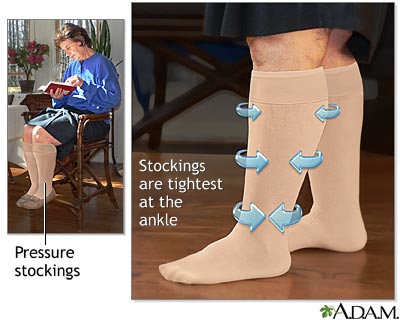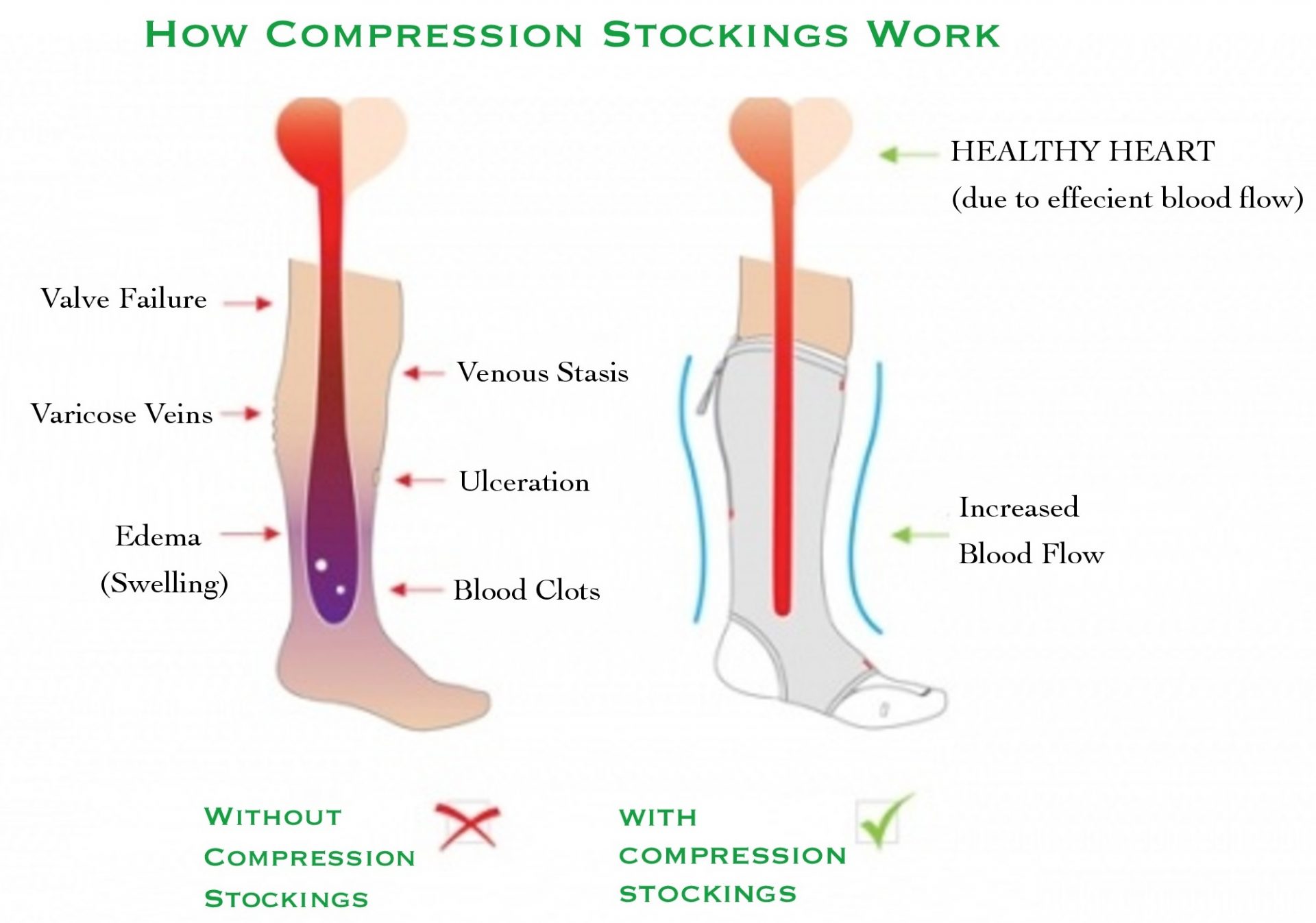Compression Socks And Blood Pressure Compression socks can help improve blood circulation and lower blood pressure by providing consistent pressure to the legs. They work by promoting better blood flow and preventing blood from pooling in the lower extremities.
Wearing compression socks can be beneficial for individuals with circulation issues or those at risk of developing high blood pressure. These specialized socks are designed to support healthy blood flow and reduce the strain on the cardiovascular system. By incorporating compression socks into your daily routine, you can potentially enhance your overall circulatory health and contribute to maintaining optimal blood pressure levels.

Credit: www.ebay.com
The Science Behind Compression Socks
How Compression Socks Work
Compression socks are designed to apply gentle pressure to your legs, promoting better blood flow and circulation. The graduated compression, tighter at the ankle and gradually decreasing up the leg, helps to push blood upward, preventing it from pooling in the lower extremities. This improved circulation can reduce the risk of blood clots and swelling, making compression socks a valuable tool for those at risk of deep vein thrombosis (DVT) or varicose veins.
Benefits Of Compression Socks
Wearing compression socks can offer a range of benefits, particularly for individuals with hypertension. The improved blood flow resulting from compression socks can help to lower blood pressure by reducing the strain on the heart. Additionally, the increased circulation can aid in reducing swelling and discomfort in the legs, providing relief for those with edema or other circulatory issues.

Credit: crazycompression.com
Understanding Blood Pressure
Compression socks can help regulate blood pressure by improving circulation. The gentle pressure from the socks aids in preventing blood from pooling in the legs, ultimately reducing the risk of high blood pressure and related complications. Understanding the benefits of compression socks on blood pressure is essential for maintaining overall health.
Understanding Blood Pressure
The force of blood pressing against the artery walls as the heart circulates blood throughout the body is known as blood pressure.. It is essential for the body to function properly, but high blood pressure can lead to serious health issues. Let’s delve into what blood pressure is and the effects of high blood pressure.
What is Blood Pressure?
The force that the blood applies to the artery walls is known as blood pressure. It has two digits and is expressed in millimeters of mercury (mmHg). The top number, known as systolic pressure, represents the force when the heart beats, while the bottom number, diastolic pressure, indicates the force when the heart rests between beats. Generally speaking, a normal blood pressure reading is 120/80 mmHg.
Effects of High Blood Pressure
1. Increased Risk of Heart Disease: High blood pressure can lead to the hardening and narrowing of the arteries, increasing the risk of heart disease and stroke.
2. Damage to Organs: The increased pressure can cause damage to the heart, kidneys, and other organs, leading to complications such as heart failure and kidney disease.
3. Vision Problems: High blood pressure can damage the blood vessels in the eyes, leading to vision problems and even blindness.
4. Risk of Aneurysm: The force of high blood pressure can weaken the walls of the arteries, increasing the risk of aneurysms.
It’s important to understand the impact of high blood pressure on the body to take proactive measures in maintaining a healthy lifestyle and seeking appropriate medical attention when necessary.
Link Between Compression Socks And Blood Pressure
Compression socks are often recommended for individuals with various health conditions, including those related to blood pressure. Many people wonder about the link between compression socks and blood pressure. In this post, we’ll explore the connection and understand how compression socks may affect blood pressure regulation.
Studies On Compression Socks And Blood Pressure
Several studies have investigated the effects of compression socks on blood pressure. A study published in the Journal of Hypertension found that wearing compression socks led to a significant reduction in both systolic and diastolic blood pressure levels. Additionally, a review published in the American Journal of Hypertension concluded that compression therapy, including the use of compression socks, can effectively lower blood pressure in individuals with hypertension.
Mechanism Of Blood Pressure Regulation
The mechanism behind how compression socks impact blood pressure regulation is related to their ability to improve circulation. Compression socks exert pressure on the legs, helping to promote better blood flow and prevent pooling of blood in the lower extremities. This enhanced circulation can lead to a decrease in the workload of the heart, ultimately contributing to the reduction of blood pressure levels.
Choosing The Right Compression Socks
When it comes to managing blood pressure and circulation issues, choosing the right compression socks is crucial. Compression socks are designed to provide graduated pressure to the legs, helping to improve blood flow and reduce the risk of complications related to blood pressure. Here are some key factors to consider when selecting the right compression socks for your needs:
Different Levels Of Compression
Compression socks are available in different levels of pressure, typically measured in millimeters of mercury (mmHg). The right level of compression for you will depend on your specific needs and the advice of your healthcare provider. Here are the common levels of compression and their recommended uses:
| Compression Level | Pressure Range (mmHg) | Recommended Use |
|---|---|---|
| Light Compression | 8-15 mmHg | Prevent mild swelling and discomfort |
| Medium Compression | 15-20 mmHg | Reduce swelling, improve circulation |
| Firm Compression | 20-30 mmHg | Manage moderate to severe swelling and varicose veins |
| Extra-Firm Compression | 30-40 mmHg | Treat severe swelling and venous disorders |
Finding The Right Fit
Ensuring that your compression socks fit properly is essential for their effectiveness. Here are some tips for finding the right fit:
- As per the manufacturer’s instructions, measure your legs to find the right size.
- Ensure the socks are snug but not overly tight, with no wrinkling or bunching.
- Consider the length and style of the socks to ensure they provide adequate coverage and comfort.
Using Compression Socks For Improved Circulation
Compression socks can be a game-changer when it comes to improving circulation in your legs. These specialized socks apply gentle pressure to your lower legs, helping to promote better blood flow and reduce swelling.
Daily Wear Recommendations
- Wear compression socks daily for best results.
- Before getting out of bed in the morning, put them on.
- Take them off before bed to allow your legs to rest.
Tips For Maximum Benefits
- Choose the right size for a comfortable fit.
- Wash your socks regularly to maintain effectiveness.
- Rotate different pairs to prevent wear and tear.
Lifestyle Changes To Support Healthy Circulation
Lifestyle changes play a crucial role in supporting healthy circulation, particularly for individuals with blood pressure concerns. By incorporating certain habits into your daily routine, you can promote better circulation and overall cardiovascular health. Here are some key lifestyle adjustments that can aid in maintaining healthy blood pressure and circulation.
Importance Of Regular Exercise
Engaging in regular physical activity is essential for promoting healthy circulation and blood pressure. Exercise helps to strengthen the heart, improve blood flow, and reduce the risk of developing hypertension. On most days of the week, try to get in at least 30 minutes of moderate-intensity exercise. Activities such as brisk walking, cycling, swimming, and yoga can be beneficial for enhancing circulation and supporting overall cardiovascular health.
Balanced Diet And Hydration
A balanced diet rich in nutrient-dense foods is vital for supporting healthy blood pressure and circulation. Make sure your meals are full of nutritious grains, lean proteins, fruits, and veggies. Additionally, limit your intake of sodium, saturated fats, and added sugars as these can negatively impact circulation and blood pressure. Staying well-hydrated is also important for maintaining healthy blood flow, so be sure to drink an adequate amount of water throughout the day.
Potential Risks And Precautions
It is important to be aware of the potential risks and precautions associated with wearing compression socks, especially for individuals with certain health conditions. Understanding when not to use compression socks and consulting a healthcare professional are crucial steps to ensure their safe and effective use.
When Not To Use Compression Socks
- Avoid wearing compression socks if you have severe peripheral arterial disease.
- Do not use compression socks if you have skin infections or dermatitis on your legs.
- Avoid wearing compression socks if you have untreated congestive heart failure.
Consulting A Healthcare Professional
- Consult your healthcare provider before using compression socks, especially if you have diabetes.
- Seek medical advice if you have a history of blood clots or deep vein thrombosis.
- Discuss with your doctor if you have any circulation issues or neuropathy in your legs.
Final Thoughts On Compression Socks And Blood Pressure
Learn about the potential benefits of using compression socks to help manage blood pressure levels effectively. These specialized socks can aid in improving circulation and reducing swelling, contributing to better overall cardiovascular health. Consider incorporating compression socks into your daily routine to support your blood pressure management efforts.
Incorporating Compression Socks Into Daily Routine
Wearing compression socks daily is an effective way to manage blood pressure and prevent complications related to hypertension. Incorporating compression socks into your daily routine is simple and easy. You can wear them while performing your daily activities, including exercise, work, or travel. It’s essential to choose the right compression level and size to ensure maximum benefits. Compression socks come in different styles and colors, making them fashionable and comfortable to wear.
Monitoring Health Changes
Regular monitoring of blood pressure and other health changes is crucial when wearing compression socks. It’s essential to keep track of your blood pressure readings and report any significant changes to your doctor. Compression socks may cause a slight drop in blood pressure, which is beneficial for people with hypertension. However, if you experience any discomfort or significant changes in your health, you should seek medical attention immediately.
In conclusion, compression socks are an excellent tool for managing blood pressure and preventing complications related to hypertension. Incorporating compression socks into your daily routine is easy and can provide significant health benefits. Regular monitoring of your health changes is crucial to ensure that compression socks are working effectively. If you’re considering wearing compression socks, consult your doctor to determine the best compression level and size suitable for your needs. Remember, prevention is always better than cure.

Credit: www.mountsinai.org
Frequently Asked Questions
Can Wearing Compression Socks Lower Blood Pressure?
Compression socks can help lower blood pressure by improving blood flow and circulation. They work by squeezing the legs and feet, which helps prevent blood from pooling and reduces the workload on the heart. However, it is important to consult with a doctor before using compression socks as a treatment for high blood pressure.
When Should You Not Wear Compression Socks?
Avoid wearing compression socks if you have skin infections, open wounds, or peripheral artery disease. Consult a doctor before use.
Do Compression Socks Affect Heart Rate?
Compression socks can help improve circulation, reducing heart rate during physical activity. They provide gentle pressure to the legs, aiding blood flow and oxygen delivery to muscles. This can result in better performance and lower heart rate.
Does Compression Therapy Help With Blood Pressure?
Compression therapy can help improve blood circulation and reduce swelling, potentially aiding in regulating blood pressure.
Conclusion
Overall, compression socks have been proven to be a beneficial tool in managing high blood pressure. They work by improving blood flow and reducing swelling in the legs, which can ultimately lead to a decrease in blood pressure. While they should not be used as the sole treatment for hypertension, they can certainly be used in conjunction with other methods for optimal results.
Additionally, it is important to consult with a healthcare professional before using compression socks or making any changes to your treatment plan.


